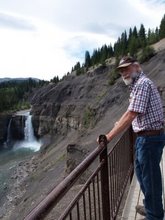February 18, 2010: Last week, on Feb. 11th, the Solar Dynamics Observatory (SDO) lifted off from Cape Canaveral on a five-year mission to study the sun. Researchers have called the advanced spacecraft the "crown jewel" of NASA's heliophysics fleet. SDO will beam back IMAX-quality images of solar explosions and peer beneath the stellar surface to see the sun's magnetic dynamo in action. SDO is designed to amaze—and it got off to a good start.
"The observatory did something amazing before it even left the atmosphere," says SDO project scientist Dean Pesnell of the Goddard Space Flight Center. Moments after launch, SDO's Atlas V rocket flew past a sundog hanging suspended in the blue Florida sky and, with a rippling flurry of shock waves, destroyed it. Click on the image below to launch a video recorded by 13-year-old Anna Herbst at NASA's Banana River viewing site—and don't forget to turn up the volume to hear the reaction of the crowd.
"I couldn't believe my eyes," says Anna. "The shock waves were so cool." Anna traveled with classmate Amelia Phillips three thousand miles from Bishop, California, to witness the launch. "I'm so glad we came," says Amelia. "I've never seen anything like it!"
Sundogs are formed by plate-shaped ice crystals in high, cold cirrus clouds. As the crystals drift down from the sky like leaves fluttering from trees, aerodynamic forces tend to align their broad faces parallel to the ground. When sunlight hits a patch of well-aligned crystals at just the right distance from the sun, voila!--a sundog.
"When the Atlas V rocket penetrated the cirrus, shock waves rippled through the cloud and destroyed the alignment of the crystals," explains atmospheric optics expert Les Cowley. "This extinguished the sundog."
In the past, says Cowley, there have been anecdotal reports of atmospheric disturbances destroying sundogs—for instance, "gunfire and meteor shock waves have been invoked to explain their disruption. But this is the first video I know of that shows the effect in action." The effect on the crowd was electric.
"When the sundog disappeared, we started screaming and jumping up and down," says Pesnell. "SDO hit a home run: Perfect launch, rippling waves, and a disappearing sundog. You couldn't ask for a better start for a mission."
SDO is now in orbit. "The observatory is doing great as the post-launch checkout continues," he reports. "We'll spend much of the first month moving into our final orbit and then we'll turn on the instruments. The first jaw-dropping images should be available sometime in April." Believe it or not, Pesnell says, the best is yet to come.
Watch movie here
Author: Dr. Tony Phillips | Credit: Science@NASA
Friday, February 19, 2010
Subscribe to:
Post Comments (Atom)

No comments:
Post a Comment